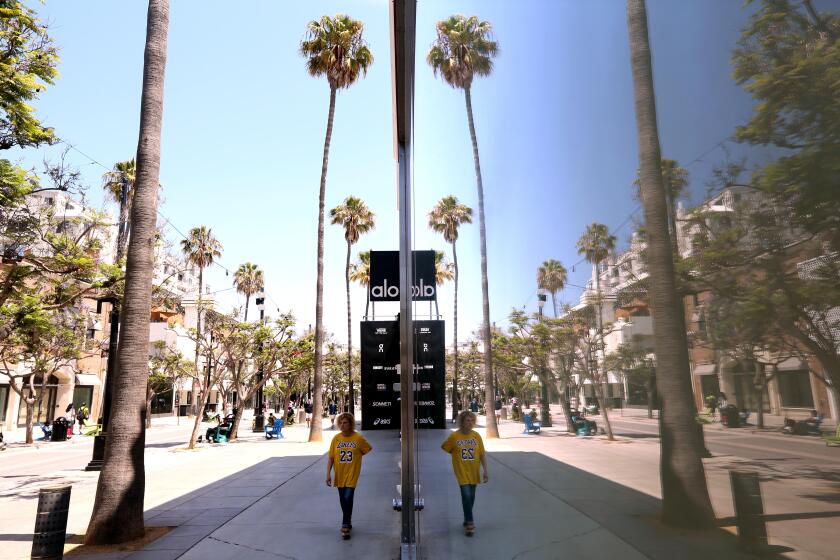Luxury outlets thriving
Luxury retailers are looking for new customers, and they’ve found them at the outlet mall.
Faced with unprecedented sales declines, Neiman Marcus, Saks Fifth Avenue and Nordstrom are among a growing cadre of high-end retailers building more outlets, where sales have fared much better.
It is a strategy that probably would have backfired during the 1980s recession, when outlets were bare-bones boxes built in the middle of nowhere and designers routinely cut out labels before selling them to off-price retailers to protect their brand’s cachet.
“These days, customers are saying they want a brand, customer service and a deal,” said Robert Wallstrom, president of Off 5th, Saks Inc.’s outlet division.
So in lieu of backwater locations, unruly piles of garments and fend-for-yourself attitudes, luxury merchants are creating an aura of prestige at their outlet stores. And they are no longer shy about setting up shop near the regional malls that once shunned them.
Indeed, as the recession makes finding a good deal not only sensible but in good taste, luxury stores are focusing more dollars and devotion on their outlets.
Saks is rolling out new prototype outlet stores under the Off 5th banner at the rate of three to five a year. The stores are clean, bright and uncluttered, with fixtures on casters that allow for quick and inexpensive makeovers as merchandise changes.
Saks has built four such prototype stores and plans to open another four this year. At that rate, the New York retailer’s stable of outlet stores will surpass the 53 Saks Fifth Avenue stores by 2010.
Cole Haan, the high-end leather goods purveyor, introduced a revamped outlet store format last fall aimed at attracting new customers to the luxury market. Its redesigned outlets have generated on average 25% more in sales than the older outlet stores, according to the company, a division of Nike Inc.
Many high-end brands have been expanding their presence at outlet stores: Kate Spade, Lucky Brand Jeans, Juicy Couture and True Religion, to name a few.
“Outlet is a good word, but it’s lost its meaning,” said Will Ander, senior partner at retail consultant McMillan Doolittle in Chicago.
Originally set up as a way to clear out excess inventory at roughly a 30% markdown, the outlet stores today operate more like a discount retailer.
Just about every outlet works with manufacturers to make products specifically for the outlet stores at a lower cost. An all-cotton shirt at the full-price store will be a cotton-rayon blend at the outlet. A handbag will have less stitching and fewer embellishments.
That’s not to say shoppers can’t find clearance goods from the full-price stores at the outlets. But much of the merchandise is either made for the outlet or purchased as overstock or canceled orders.
“There is a cachet today in the outlet category,” said branding expert Tom Julian, president of Tom Julian Group in New York. “The negativity doesn’t exist anymore. The outlet channel has a different season and structure that doesn’t always conflict or challenge the traditional retail world.”
Nordstrom Inc. often operates its outlet stores at strip centers within close proximity of its full-line stores.
The Seattle-based retailer is expanding its outlet stores at almost the same pace as its full-line stores. Through 2012, Nordstrom plans to open 32 full-line stores and 28 Nordstrom Rack stores, including 10 this year.
There is good reason for the expansion. The 56 Nordstrom Rack stores are outshining the 109 full-line stores. Same-store sales at Nordstrom Rack fell 1.5% in the company’s fiscal fourth quarter ended Jan. 31, far better than the 16% decline at the full-line Nordstrom.
At Neiman Marcus Group Inc., where same-store sales fell 23% for the fiscal second quarter ended Jan. 31, the Last Call Clearance division is on a roll. The Dallas company plans to add three Last Call clearance center stores this year.
To be sure, outlet stores alone are not going to save luxury retailers, said Hana Ben-Shabat, partner in the retail practice at A.T. Kearney. The outlets are generally smaller than the main retail stores, and with prices typically 25% to 50% below retail, they generate a small portion of the company’s overall revenue.
But where else during a recession are you likely to see a crowd of weekday afternoon shoppers standing elbow to elbow, except inside a Coach factory store at the Chelsea Premium Outlet in Aurora, Ill., as word of an unadvertised sale spread around the outdoor mall?
Two clerks directed traffic at the door. Another walked in and out of the stock armed with fresh batches of handbags and wallets. And three cashiers rang up sales as about two dozen customers stood in line.
Joan Nichols, 50, scored a $458 violet leather satchel from Coach’s Parker collection for $145. Her 19-year-old daughter, Valerie Nichols, bought a $468 cream Coach logo handbag for $130. Their savings: 70% each.
“If there is a recession,” Joan Nichols said, “it’s not apparent here.”
--
More to Read
Inside the business of entertainment
The Wide Shot brings you news, analysis and insights on everything from streaming wars to production — and what it all means for the future.
You may occasionally receive promotional content from the Los Angeles Times.










